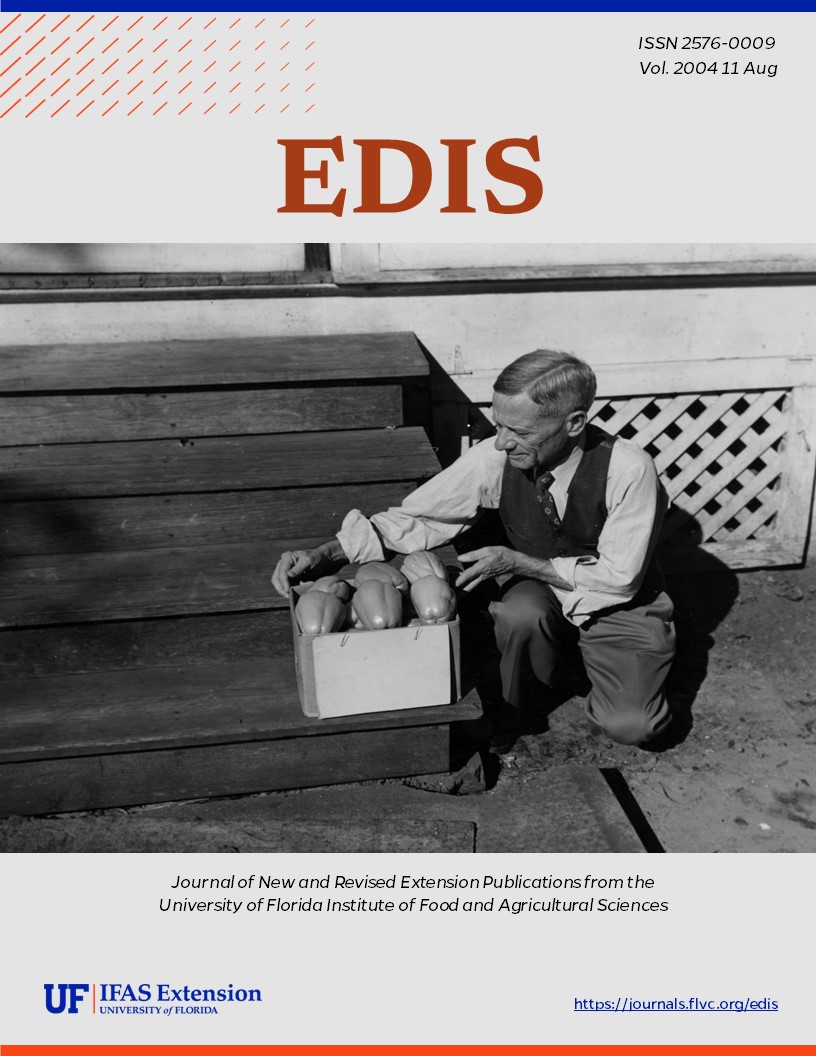Abstract
In Florida, the green lynx spider, Peucetia viridans (Hentz), is the spider most often received for identification by Division of Plant Industry entomologists. It is a conspicuous, large, bright green spider found on many kinds of shrublike plants throughout the southern United States and is the largest North American lynx spider. Although it is common throughout Florida and aggressively attacks its insect prey, it very seldom bites humans. While its bite is of little concern to humans, the green lynx spider is of interest because of its potential use in agricultural pest management. This document is EENY-249 (originally published as DPI Entomology Circular 181), one of a series of Featured Creatures from the Entomology and Nematology Department, Florida Cooperative Extension Service, Institute of Food and Agricultural Sciences, University of Florida. Published: November, 2001.
References
Banks N. 1904. The Arachnida of Florida. Proceedings of the National Academy of Science Philadelphia 56: 120-147.
Brady AR. 1964. The lynx spiders of North America, north of Mexico (Araneae: Oxyopidae). Bulletin of the Museum of Comparative Zoology 131: 429-518.
Chamberlin RV, Ivie W. 1944. Spiders of the Georgia region of North America. Bulletin of the University of Utah, biological series 8: 1-267.
Comstock JH. 1940. The Spider Book. revised ed., by Gertsch WJ. Doubleday and Co., New York. 729 p.
Emerton JH. 1902. The Common Spiders of the United States. Ginn and Co., Boston. 235 p. https://doi.org/10.5962/bhl.title.5617
Exline H, Frizzell DL, Whitcomb WH. 1965. Clarification of the mating procedure of Peucetia viridans (Araneida: Oxyopidae) by a microscopic examination of the epigynal plug. Florida Entomologist 48: 169-171. https://doi.org/10.2307/3493220
Gertsch WJ. 1949. American Spiders. D. Van Nostrand Co., New York. 285 p. https://doi.org/10.5962/bhl.title.20055
Glick PA. 1939. The distribution of insects, spiders, and mites in the air. U.S. Department of Agriculture Technical Bulletin 673: 1-150.
Hentz NM. 1832. On North American spiders. American Journal of Science and Arts 21: 99-109.
Hentz NM. 1845. Descriptions and figures of the Araneides of the United States. Journal of the Boston Society of Natural History, Part III (1845) V: 189-202.
Hentz NM. 1875. The spiders of the United States. Boston Society of Natural History, Boston, Massachusetts. 171 p.
Kaston BJ. 1948. Spiders of Connecticut. State Geol. Natural History Survey, Connecticut 70: 1-874.
Lowrie DC. 1963. Effects of grazing and intensive collecting on a population of the green lynx spider. Ecology 44: 777-781. https://doi.org/10.2307/1933029
McCook HC. 1883. Note on two new Californian spiders and their nests. Proceedings of the National Academy of Science Philadelphia 35: 276-278.
McCook HC. 1890. American Spiders and Their Spinningwork. Vol. 2. (Pub. by the author.) Philadelphia, Pennsylvania. 479 p.
Petrunkevitch A. 1911. A synonymic index-catalogue of spiders of North, Central and South America with all adjacent islands. Bulletin of the American Museum of Natural History 29: 1-791.
Pickard-Cambridge FO. 1902. Biologia Centrali-Americana, Arachnida, Araneidea and Opilones. Vol. 2. Published for the editors by R.H. Porters. London. 610 p. + plates.
Randall JB. 1976. The use of femoral spination as a key to instar determination in the green lynx spider, Peucetia viridans Hentz. Unpublished thesis. University of Florida, Gainesville, FL. 26p.
Rea PM, Bragg LM. 1909. Local fauna. Spiders. Bulletin of the Charleston Museum 5: 65-66.
Walckenaer CA. 1838. Histoire naturelle des insectes Apteres. Paris 1: 1-682. https://doi.org/10.5962/bhl.title.61095
Walckenaer CA. 1841. Histoire naturelle des insectes Apteres. Paris 2: 1-549.
Whitcomb WH. 1962. Egg sac construction and oviposition of the green lynx spider, Peucetia viridans (Oxyopidae). Southwestern Naturalist 7: 198-201. https://doi.org/10.2307/3668842
Whitcomb WH, Eason R. 1965. The mating behavior of Peucetia viridans (Araneida: Oxyopidae). Florida Entomologist 48: 163-167. https://doi.org/10.2307/3493219
Whitcomb WH, Exline H, Hunter RC. 1963. Spiders of the Arkansas cotton field. Annals of the Entomological Society of America 56: 653-660. https://doi.org/10.1093/aesa/56.5.653
Whitcomb WH, Hite M, Eason R. 1966. Life history of the green lynx spider, Peucetia viridans(Araneida: Oxyopidae). Journal of the Kansas Entomological Society 39: 259-267.
Unless otherwise specified, articles published in the EDIS journal after January 1, 2024 are licensed under a Creative Commons Attribution-NonCommercial-NoDerivs 4.0 International (CC BY-NC-ND 4.0) license.

